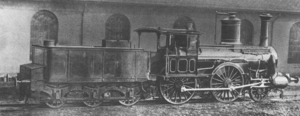Mecklenburg III
| Mecklenburg III | ||
|---|---|---|
| Numbering: | 12-23 | 24-30 |
| Number: | 12 | 7th |
| Manufacturer : | Hartmann , Chemnitz | |
| Year of construction (s): | 1864 + 1866 | 1869 |
| Retirement: | 1901-1910 | 1903-1910 |
| Type : | 1B n2 | |
| Gauge : | 1435 mm | |
| Length over buffers: | 13,750 mm | |
| Height: | 4125 mm | |
| Total wheelbase: | 4395 mm | |
| Wheelbase with tender: | 9989 mm | |
| Empty mass: | 31.30 t | |
| Service mass: | 33.90 t | |
| Friction mass: | 22.80 t | |
| Wheel set mass : | 11.40 t | |
| Top speed: | 90 km / h | |
| Coupling wheel diameter: | 1870 mm | |
| Impeller diameter: | 1065 mm | |
| Control type : | Stephenson | |
| Number of cylinders: | 2 | |
| Cylinder diameter: | 407 mm | |
| Piston stroke: | 560 mm | |
| Boiler overpressure: | 7.31 bar 8.04 bar |
8.77 bar |
| Number of heating pipes: | 188 | |
| Heating pipe length: | 3111 mm | 3311 mm |
| Grate area: | 1.25 m² | |
| Radiant heating surface: | 7.78 m² | |
| Tubular heating surface: | 71.64 m² | 77.62 m² |
| Evaporation heating surface: | 79.42 m² | 84.40 m² |
| brake | Pneumatic brake type grinder | |
|
||
In the III genus ordered Grand Duchy of Mecklenburg Friedrich-Franz Railway passenger train locomotives of the wheel arrangement 1B of the Friedrich-Franz Railway one.
history
With the commissioning of the Güstrow-Neubrandenburg line , it became necessary to procure locomotives that could easily cope with the gradients through Mecklenburg Switzerland . The previous type 1A1 locomotives (the later classes I and II ) were no longer sufficient.
The Friedrich-Franz-Eisenbahn therefore bought 19 locomotives with the wheel arrangement 1B in three series in 1864, 1866 and 1869 from Richard Hartmann from Chemnitz. The locomotives were named after cities in northern Germany. Two locomotives were given the names TWO HUNDRED and FOUR HUNDRED because of their serial numbers . The locomotives were in use until after the turn of the century. The retirement took place from 1903 to 1911.
Constructive features
The locomotives had an internal fork frame. The long boiler had three shots. In the middle section sat a large steam dome that was the same height as the short cylindrical chimney. The cathedral was decorated with brass rings . The standing boiler was provided with a safety valve in a valve attachment.
The two-cylinder wet steam engine was external. The valve boxes and the Stephenson controls were inside. The horizontally arranged cylinders worked on the first coupling axis.
The coupling axles were cushioned by overhead leaf springs. A compensation lever at the level of the axle bearing connected the two springs. In the last delivery series from 1869, the leaf springs were arranged below the coupling axle bearings. On the barrel axle, the leaf spring package was above the frame.
The locomotives had a pneumatic brake type grinder. The sandpit was in front of the first driving axis and sanded it from the front.
The machines were used with type 3T 7.9 tenders.
literature
- Hans-Joachim Kirsche, Hermann Lohr, Georg Thielmann: Lokomotiv-Archiv Mecklenburg / Oldenburg . transpress, Berlin 1989, ISBN 3-344-00326-7 .
